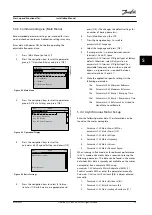
line-line value by 2 to achieve the line to
common (starpoint) value.
It is also possible to measure the value with an
ohmmeter, which takes the resistance of the
cable into account. Divide the measured value by
2 and enter the result.
6.
Parameter 1-37 d-axis Inductance (Ld)
Enter line to common direct axis inductance of
the PM motor.
If only line-line data are available, divide the line-
line value by 2 to achieve the line-common
(starpoint) value.
It is also possible to measure the value with an
inductance meter, which takes the inductance of
the cable into account. Divide the measured
value by 2 and enter the result.
7.
Parameter 1-40 Back EMF at 1000 RPM
Enter line-to-line back EMF of PM Motor at 1000
RPM mechanical speed (RMS value). Back EMF is
the voltage generated by a PM motor when no
drive is connected and the shaft is turned
externally. Back EMF is normally specified for
nominal motor speed or for 1,000 RPM measured
between two lines. If the value is not available for
a motor speed of 1000 RPM, calculate the correct
value as follows: If back EMF is, e.g., 320 V at
1800 RPM, it can be calculated at 1000 RPM as
follows: Back EMF = (Voltage / RPM)*1000 =
(320/1800)*1000 = 178. This is the value that
must be programmed for
parameter 1-40 Back
EMF at 1000 RPM
.
Test motor operation
1.
Start the motor at low speed (100 to 200 RPM). If
the motor does not turn, check installation,
general programming and motor data.
2.
Check if start function in
parameter 1-70 PM Start
Mode
fits the application requirements.
Rotor detection
This function is the recommended choice for applications
where the motor starts from standstill, e.g., pumps or
conveyors. On some motors, an acoustic sound is heard
when the impulse is sent out. This does not harm the
motor.
Parking
This function is the recommended choice for applications
where the motor is rotating at slow speed, e.g.,
windmilling in fan applications.
parameter 2-06 Parking
Current
and
parameter 2-07 Parking Time
can be adjusted.
Increase the factory setting of these parameters for
applications with high inertia.
Start the motor at nominal speed. If the application does
not run well, check the VVC
+
PM settings. Recommen-
dations for different applications can be seen in
Application
Settings
Low inertia applications
I
Load
/I
Motor
<5
Parameter 1-17 Voltage filter time
const.
to be increased by factor 5 to
10
parameter 1-14 Damping Gain
should
be reduced
parameter 1-66 Min. Current at Low
Speed
should be reduced (<100%)
Low inertia applications
50>I
Load
/I
Motor
>5
Keep calculated values
High inertia applications
I
Load
/I
Motor
> 50
Parameter 1-14 Damping Gain
,
parameter 1-15 Low Speed Filter Time
Const.
and
parameter 1-16 High
Speed Filter Time Const.
should be
increased
High load at low speed
<30% (rated speed)
Parameter 1-17 Voltage filter time
const.
should be increased
parameter 1-66 Min. Current at Low
Speed
should be increased (>100%
for a prolonged time can overheat
the motor)
Table 5.8 Recommendations for Different Applications
If the motor starts oscillating at a certain speed, increase
parameter 1-14 Damping Gain
. Increase the value in small
steps. Depending on the motor, a good value for this
parameter can be 10% or 100% higher than the default
value.
Starting torque can be adjusted in
parameter 1-66 Min.
Current at Low Speed
. 100% provides nominal torque as
starting torque.
5.4.6 Automatic Energy Optimization (AEO)
NOTICE!
AEO is not relevant for permanent magnet motors.
AEO is a procedure which minimizes voltage to the motor,
thereby reducing energy consumption, heat, and noise.
To activate AEO, set
parameter 1-03 Torque Characteristics
to
[2] Auto Energy Optim. CT
or
[3] Auto Energy Optim. VT
.
Start-up and Functional Tes...
Installation Manual
MG37A322
Danfoss A/S © Rev. 04/2015 All rights reserved.
59
5
5
















































